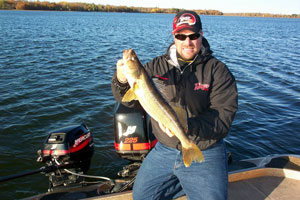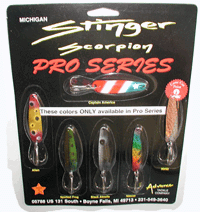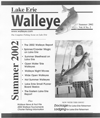|
Sweating the Small Stuff
By Mark Leadens
Paying attention to
details can pay big dividends, especially if you happen to be a walleye
 angler.
There are times when even the smallest detail makes the difference between a
good catch and a good skunking. Knowing that a small thing like a special
lure, or a particular color, or certain type of live bait can make a
difference keeps anglers like me heading back to the bait shop to find an
edge. angler.
There are times when even the smallest detail makes the difference between a
good catch and a good skunking. Knowing that a small thing like a special
lure, or a particular color, or certain type of live bait can make a
difference keeps anglers like me heading back to the bait shop to find an
edge.
While it might seem a
little crazy to some, itís putting an extra fish or two in the boat for
someone else. Anglers that are doing the right things in the right places
for the most part are going to catch their share of fish, but when things
get tough or when old marble eyes gets a little fussy itís paying attention
to details that will win the day.
Understanding why
walleyes are where they are is an extremely important detail and really
should be explored, especially if youíre going to get the most out of a
situation. In most cases the answer can be found in the groceries, as
walleyes are almost always led around by their stomachs. Determining what
type of food source the fish are relating to will go a long way towards
uncovering productive details. For example, walleyes foraging on schools of
shiner minnows might be holding tight to a sandy shoreline early in the
season, or suspended out over deep water later in the summer. If perch are
the target walleyes might be found foraging along weed edges early in the
season, and may move to deeper main lake structure for most of the summer
period, and then head back to the weeds by early fall. A forage base that
consists of smelt or alewives may keep walleyes holed up miles away from
anything considered ďclassicĒ walleye structure, and where they can be
expected to be found suspended for most of the open water season.
Once youíve determined
what theyíre after itís easier to get a handle on where the might be found
and you can start to uncover the smaller details. Details like whether or
not walleyes are holding tight to a break line, or over hard or soft bottom,
or maybe stacked up along the transition line where soft meets hard is what
youíre trying to find. Concentrations are usually the key, but not always.
There are times when fish found spread out are the ones actively feeding,
and those piled up in the heaviest concentrations are taking a nap. Thatís
one of the details that needs to be determined and is done by spending some
time working both situations. The moral of the story is that fewer fish
that bite are much better than a mother load with lock jaw.
Another detail involves
a particular depth that holds most of the active fish. Walleyes that are
spread up and down a break may not all be active at the same time and there
could easily be a certain depth where you catch most of the fish. If youíre
able to find that magic depth you can concentrate your time in the most
productive water allowing you to maximize your opportunities.
Once youíve determined
the forge, got a handle on location, and even found most of the biters, you
can work on the tiniest details like lure color or bait type. The teeny
tiny details can turn a good catch into something that dreams are make of.
On the other hand it might mean nothing more than an extra fish or two at
the end of the day, but what if that extra fish happens to be a real
trophy?
Tournament anglers get
pretty well wrapped up in lure color as they know the right bait with the
right color can turn into a big payday, and is why they have boxes full of
different shapes, sizes, and colors of just about every jig, crank bait, or
spinner blade there is. Getting caught without the right gear can be
embarrassing and painful, not to mention the financial implications.
How walleyes respond
with or without cloud cover is another seemingly minute detail that can
actually make a difference. You might find that a hot bite shuts down
absent any cloud cover, or visa versa. Or that they prefer a particular
color when the sun is out and something completely different when the clouds
take over.
Itís all part of the
program and you can easily see that sweating over the small stuff might be
well worth effort. |





